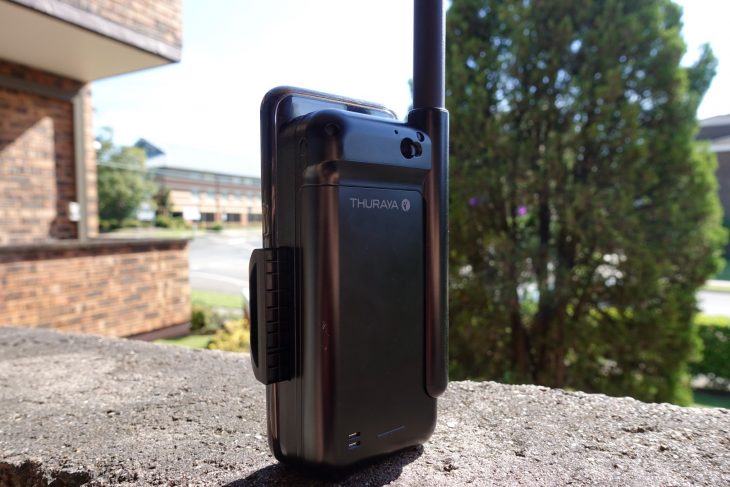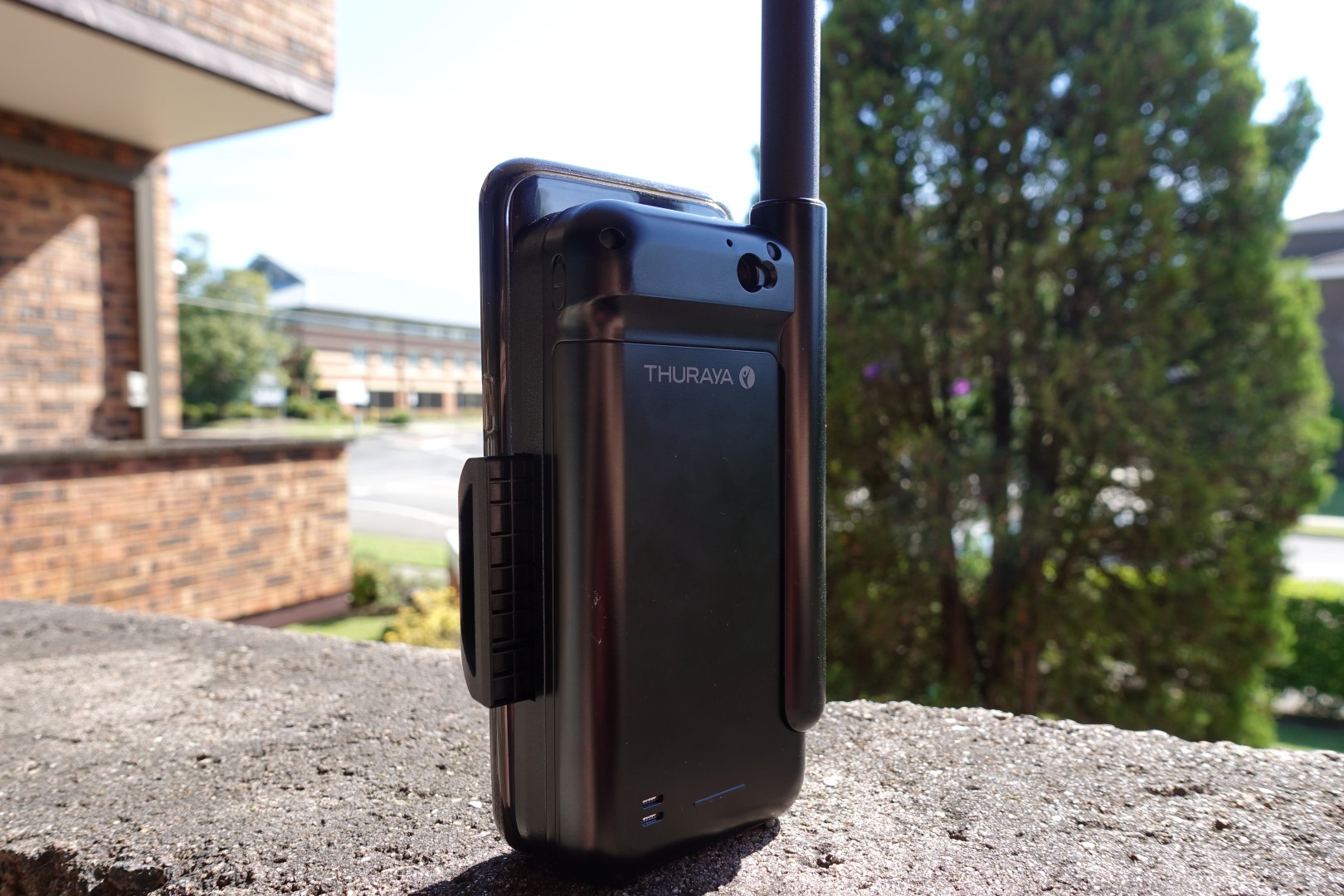
For the last week, I’ve been testing out something which many of the average consumers probably won’t have a need to use — a satellite communication service. However, you can push out of your mind the images of clunky phones carried in a shoulder bag; Pivotel’s SatSleeve for use on the Thuraya satellite network is a simple clip-on addition to whatever smartphone you happen to be using — in this case, a brand-spanking Galaxy S8 from Samsung.
Rather than just tell you about what the service offers (which you can read about here in more detail), I thought I’d take the SatSleeve out and about around Sydney (and into the bush in Sydney’s north west) to try out satellite comms and how they work in 2017.
What’s it like to setup the SatSleeve?
Initial setup of the SatSleeve from Pivotel is very easy; it’s not unlike setting up any other phone.
All you need do is take the SatSleeve from its box (it’ll have a bit of charge for initial setup), pop in your supplied SIM card, charge the battery (if you wish) and turn it on. Finding a satellite lock isn’t tricky, provided you read the instructions and have a basic understanding of your bearings.
Find a clear, unobstructed view of the sky, look to the north, turn left slightly towards North West, and aim the SatSleeve antenna in that direction, and you’ll have strong service on the SatSleeve within a few moments. Thuraya’s Thuraya-3 satellite is the one you’re aiming for, and it’s in geo-synchronous orbit above Singapore making it fairly easy to find, provided you have a good view of the sky.
Pairing with your selected smartphone is easy, too. Simply turn on your WiFi, look for the SatSleeve’s WiFi access point, and enter the supplied password (usually 12345678). You’re connected, and ready to make/receive calls, and send SMS.
You have to bear in mind, though, that the reception can quicky disappear if you lose sight of the satellite; aiming the antenna in the wrong direction, or something obstructing its path will lose signal, but more on that below. You can tell whether there’s signal or not with the signal bar display in the app, and it’ll show either ‘Searching…’ or ‘Thuraya’ when it finds the network.
We found the process of making a call and sending an SMS to be very intuitive, and anyone with even a passing familiarity with modern smartphones will have no issue using this service, and be communicating via satellite. It’s seriously that simple.
Using the SatSleeve with the Pivotel Thuraya Big Bundle
Many people think that satellite comms are slow and clumsy, but with the Big Bundle from Pivotel, it really isn’t. Making calls is quick, and call quality is high, though there is of course the tell-tale satellite audio delay (much like making an international call used to be when I was a kid). Beyond this, though, you might as well be talking on any other phone, but from anywhere there’s satellite coverage.
Like anything, though, there are moments when it doesn’t quite work as well as the brochure describes. To really test out the quality of a satellite call over Thuraya, I set up in a nice, open park, set up the SatSleeve in the SatHotSpot configuration (i.e. where it sits on the bench like a little WiFi hotspot, instead of clipped to your phone) so it wouldn’t move, and got it connected up. It took thirty seconds or so from powering on until it had signal and service, and then I got the phone set up. Easy.
I dialed up my partner Rachel and we chatted on the phone for ten minutes or so. During the conversation, we dealt with the satellite audio lag, but on a couple of occasions, the call quality on Rachel’s end was such that I had to repeat what I’d said. However, all in all, the phone call went without a hitch, from out the back of Richmond, New South Wales, to the Thuraya-3 satellite over Singapore and back down to earth, and back again.
Sending SMS works rather well too, though there can be delays which mean your SMS doesn’t arrive immediately, taking some minutes (even up to 15 minutes) sometimes. There wasn’t ever a clear reason for this — messages sent with strong signal either came through immediately or after some time — but there’s a number of variables beyond our control which could be at play.
Would I want to use satellite comms for every call or SMS I send/make? No, definitely not. It’s too expensive, and too clunky. However, it’s a bloody good option where there aren’t options; if you’re somewhere that there’s no mobile reception, a satellite phone is likely your only choice.
Would I recommend the Thuraya SatSleeve from Pivotel?
If you need satellite-based communications, then yes, this is a fantastic option. The pricing for the device itself, and for the plan, is competitive, and offers all the inclusions the average user really needs.
Pivotel’s Big Bundle makes the service offering ultra-affordable for the first time that we’re aware of in the satellite comms space. For a reasonable $99 a month, users get two services in one: a standard mobile service to use when they’re in areas with mobile coverage, and huge inclusions each month to use when off the beaten track via the satellite service.
Unlike some other satellite services, whichever service you choose through Pivotel comes with a standard Australian mobile number, which gives you a few advantages:
- It’s usually pretty cheap (or effectively free) for most other people to call you.
- There’s no international dialing codes or other nonsense to remember.
- You can readily divert your cellular mobile service to your satellite service, and vice versa, at next to no cost.
Ease of use is what this is all about, and the SatSleeve is a very easy way to jump into satellite comms without having to use a stand-alone phone with its own menu systems and features you need to learn. Sure, you might think, it’s just another device I need to charge and carry around, and it is, but it uses the power of your smartphone to make it easy and more accessible.
What if your smartphone goes flat though? You can still send an SOS message from the Satsleeve without the smartphone, and you can receive calls as well — the Satsleeve has a built-in speaker and microphone that’s perfectly serviceable for receiving calls.
All in all, the more regular user of satellite comms may prefer a standalone device rather than something which requires your smartphone to fully use. I can understand that. For the somewhat more casual user though, for the family that goes camping during the school holidays, or the remote worker who might spend a few days each month in the wilderness… this is a great solution, and it’s hard to beat.
This is the first of our Into the Wild series, where we’ll take a look at satellite communication options for those of you who like to get … into the wild! Let us know if you’re keen to see more of this kind of content.












I was told that some phone companies don’t allow you to call as the sat call cost is passed onto the carrier? And thuraya has a stationery satt above Indonesia so not coverage everywhere ?
So, apparently, Optus USED to prevent calls to Pivotel’s 04xx numbers, but now they can be called from anywhere for normal mobile rates. That’s what we’re told, anyway. As for Thuraya, we understand the satellite for our region is over Singapore, but that’s pretty close to Indonesia so same same. It’s true, coverage isn’t global with Thuraya, but most places in Australia, if you have a reasonable view of the sky, you’ll lock onto the satellite without issue. Inmarsat works the same way; geosynchronous orbit at the equator, meaning you need the same kind of view of the sky to… Read more »